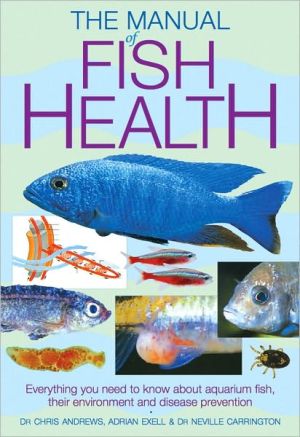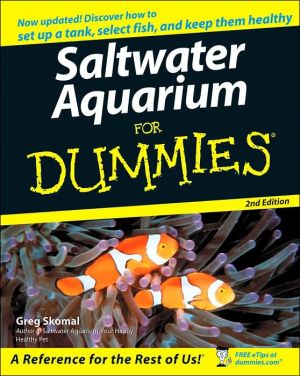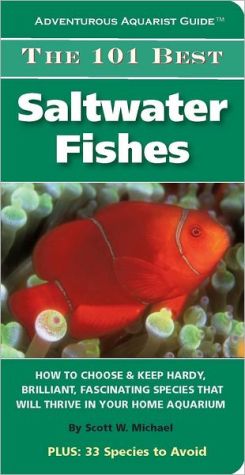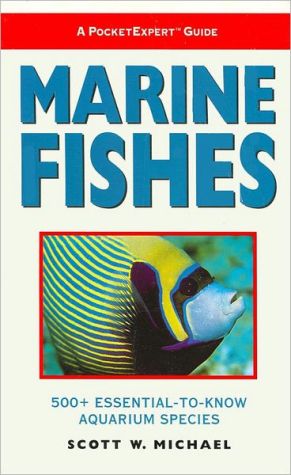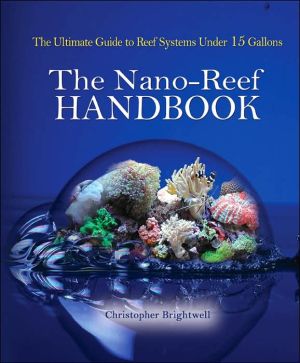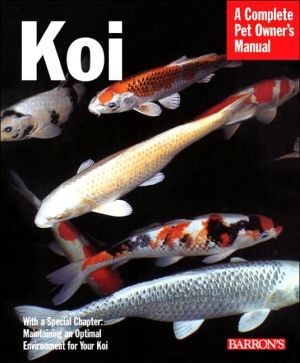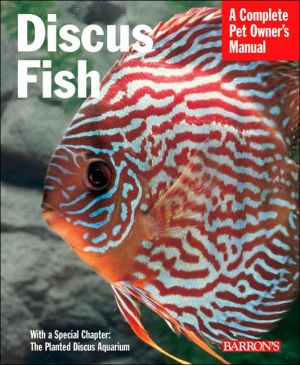Manual of Fish Health: Everything You Need to Know About Aquarium Fish, Their Environment and Disease Prevention
A comprehensive guide to keeping fish healthy for the serious hobbyist.\ A healthy environment is crucial for any aquarium. Fish need more than a tank of water and a daily sprinkle of food to stay healthy, and the fish-keeper is regularly challenged to understand irregularities that can cause trouble.\ Manual of Fish Health is a fully illustrated and highly informative reference that concentrates on:\ \ Maintaining a healthy aquatic environment\ \ Recognizing and coping with pests, diseases,...
Search in google:
Health care for all types of fishes: freshwater and marine, tropical and temperate, pond and aquarium.
Chapter 1: The Balance of Health\ As a fishkeeper, you must accept a basic obligation to the totally dependent creatures in your care. Your first priority must be to provide the best possible conditions to safeguard their health and to promote their well-being. Accepting and discharging this responsibility to the full yields three fundamental benefits. First, it will minimize stress on the fish, which is unavoidable in their unnatural captive environment. Secondly, it will lead to relatively trouble-free fishkeeping. And thirdly, well-cared-for fishes will reward you by displaying their best colors and their most natural behavior for you to enjoy.\ In this opening section, we look briefly at the relationship between fish, their environment and the pathogens (i.e. the disease-causing organisms) that potentially threaten their health and survival.\ Fish, pathogens and the environment\ Since fish consist of 80 percent of the raw material that makes up the environment in which they live -- namely water -- and only a simple membrane separates the two, it is not surprising that fish are uniquely influenced by any alterations in the environment and that any fluctuations have a significant impact on their health.\ Many potential fish pathogens are a constant and natural part of the environment, usually without causing disease problems and mortality. For example, fish usually carry small populations of protozoan parasites that feed mainly off surplus tissue and are kept under control by the fish's immune system. After all, it is not usually in a parasite's interest to kill its host. (There are some exceptions, however, where the parasite's life cycle involves killing the fish so that it is eaten by the next scavenging stage in the cycle.)\ This unique relationship between fish, their pathogens and the total environment in which they live means that under normal environmental circumstances there is a balance between the fish and the pathogens. In this case, the fish's immune system keeps any problems under control. However, if there is an alteration in one or more of the environmental characteristics then there may be a shift in the balance to the benefit or detriment of either the fish or the pathogen. An example of an environmental change that runs counter to a pathogen is a fall in temperature that reduces the virulence of that pathogen, by slowing down its rate of multiplication or even halting its life cycle.\ If the environmental shift is against the fish, then -- in addition to any direct physiological impact -- the fish usually becomes stressed, its immune system is suppressed and it becomes more susceptible to disease. In this situation a disease outbreak may occur, particularly if the environmental shift also favors the pathogen. As an example Flexibacter bacteria are commonly present in fish-holding water, but the fish's immune system keeps them at bay. However, when excess food rots in the environment the bacterial population rises and, as the bacteria break the food down, they produce excess amounts of ammonia. Ammonia is a toxin that irritates the fish's gills, causing them to overproduce a layer of cells on the delicate gill surface. Since these cells are more prone to bacterial infection, the combined effect of these circumstances is an episode of bacterial gill disease in the fish.\ Another relevant disease-causing factor is the introduction of disease organisms into the environment on fish, plants or decorations. This can result in the introduction of some types of pathogen that, as a consequence of their action, inevitably kill the fish host. The introduction of different types or strains of pathogens will also upset the natural immunobiological balance of a community of fishes. The indigenous fishes will have developed a degree of immunity to most of the disease organisms in their environment but may not have encountered the new strains of pathogen being brought in. On the other hand, the newly introduced fishes will also have to develop an immunity to the population of pathogens in their new environment. Therefore, introducing new fishes greatly increases the chances of a disease outbreak occurring. This underlines the importance of careful quarantining, a simple precaution that reduces the likelihood of disease when you are building up a fish population from different sources. (For guidance on quarantine, see pages 70-73.)\ Stress and disease\ Stress is a vital factor in fish health. The varied forms it takes and its effects on fish have been investigated by biologists and fisheries scientists in both wild and captive fish populations. Here, we draw some simple conclusions from what is a highly complex story.\ Factors that have a negative impact on fishes, such as handling, overcrowding, poor environmental conditions and unsuitable or aggressive tankmates, are called 'stressors'. The stress response these stressors cause is defined as the sum of the physiological responses the fish makes to maintain or regain its normal balance. Some stress responses are common to all stressors; others are specific to one particular type.\ The most basic stress response is to escape from imposed danger, which may take the form of a natural predator or, in captivity, the fishkeeper attempting to catch the fish in a net for closer examination or transfer it to another tank or pond. The first part of this response is the preparation of the body for escape, which, in biological terms, involves the release of hormones that channel all the fish's energy to power the locomotory muscles. Unfortunately, this alarm response has long-term detrimental effects. For example, one of the hormones released is adrenaline, which apart from 'quickening' the body for instant action also disturbs the osmoregulation (i.e. control of the salt/water balance) within the fish. Another hormone involved, cortisol, affects the white blood cells and reduces their effectiveness in the immune system. The second part of the response involves the recovery of the fish's equilibrium. Thus, the alarm response is clearly a compromise between the short-term need to reach immediate safety and the longer term side-effects of the physiological changes involved. It can be an uneven compromise; a fish that undergoes an alarm response as a result of stress applied for even a short period of time can take hours or even days to recover its equilibrium.\ The stress response in fish is generally considered to be less well suited to reacting to chronic environmental stressors. This is because fish have evolved in a relatively stable natural environment and have not, therefore, developed an effective system to deal with environmental changes or chronic stressors. In the case of a negative environmental change, a fish's first response is also an alarm stage, in which it attempts to get away from the problem. If escape is not possible, then it is followed by an adaptive stage during which the fish's body attempts to react to the environmental change. Initially the fish's physiological compensation tends to over-react. Then, over a longer term, it returns to a new equilibrium in which the fish reaches optimum adaptation, both physiologically and behaviorally, to survive the new environmental conditions. During the adaptive stage of the stress response, the fish channels much of its resources into dealing with the stressor. As a result, its immune system functions less effectively and hence the fish is more prone to disease problems.\ Although a fish may successfully adapt to new conditions, its performance in terms of growth, breeding and disease immunity may be reduced. This adaptive stage may last from four to six weeks. If a fish is constantly exposed to stressors such as a steady deterioration of environmental conditions or continual bullying by tank-mates the adaptive stress response is likely to be so extended, and the fish's normal functions so disturbed, that its chances of survival are significantly reduced. If the environmental change is so great that the fish cannot compensate -- then the fish's stress response finally reaches a fatal exhaustion stage.\ Although stressors and the fish's stress response can result in the fish succumbing to disease because of the immune system's reduced effectiveness, the diseases themselves can also be considered as stressors in their own right. In this case, the fish's adaptive response is an attempt to counter the disease effects.\ Even from this simple introduction it is clear that minimizing stress is an extremely important part of good fishkeeping. How to reduce it at every possible stage is a recurring theme in all the fishkeeping advice given throughout this book. Without doubt, careful forethought and planning, and effective management of water quality and fish populations, are the key elements in successful trouble-free fishkeeping. As with many health-related endeavors, the old adage is consistently true: prevention is far better than a cure.
How to Use This BookChapter 1: The Balance of HealthChapter 2: Living in WaterChapter 3: Understanding Water ChemistryChapter 4: Planning for HealthChapter 5: Recognizing Ill-HealthChapter 6: An A-Z of Common Pests and DiseasesChapter 7: A Guide to TreatmentIndexPicture Credits
